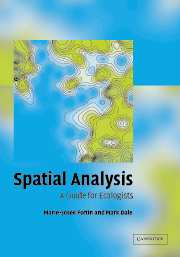Book contents
1 - Introduction
Published online by Cambridge University Press: 29 July 2009
Summary
Introduction
Processes in natural systems and the patterns that result from them occur in ecological space and time. To study natural structure and to understand the functional processes we need to identify the relevant spatial and temporal scales at which these all occur. While the spatial and temporal dimensions of ecological phenomena have always been an inherent part of the conceptual framework of ecology, it is only recently that they have been incorporated explicitly into ecological theory, sampling design, experimental design and models (Levin 1992). For example, McIntosh (1985), in describing the concepts and theory that form the background of ecological studies, included very little discussion about the spatial aspects of ecological processes. In recent years, however, a growing number of texts have addressed spatial questions by providing both a spatial framework perspective and spatial statistics to perform spatial analyses, for example Cliff & Ord (1973, 1981), Getis & Boots (1978), Ripley (1981), Upton & Fingleton (1985), Anselin (1988), Haining (1990, 2003), Cressie (1991, 1993), Bailey & Gatrell (1995), Manly (1997), Legendre & Legendre (1998), Dale (1999), Fotheringham et al.(2000) and O'Sullivan & Unwin (2003).
In this book, we will concentrate on the spatial aspects of ecological data analysis to provide some advice and guidance to practising ecologists. Because all phenomena of ecological interest have both a spatial location, which can be designated by geographic coordinates, and other characteristics, such as measured attributes, we can have different perspectives on how to analyse them:
their spatial locations can be included explicitly for the purpose of understanding spatial structure and pattern;
[…]
- Type
- Chapter
- Information
- Spatial AnalysisA Guide for Ecologists, pp. 1 - 31Publisher: Cambridge University PressPrint publication year: 2005



